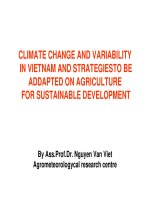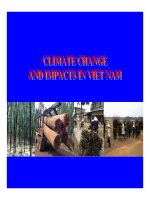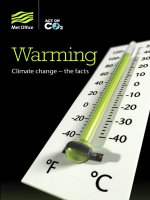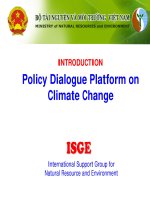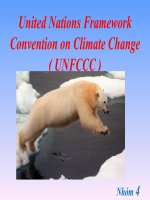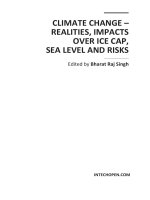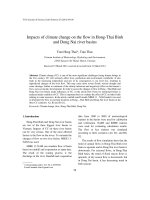CLIMATE CHANGE – REALITIES, IMPACTS OVER ICE CAP, SEA LEVEL AND RISKS potx
Bạn đang xem bản rút gọn của tài liệu. Xem và tải ngay bản đầy đủ của tài liệu tại đây (43.43 MB, 522 trang )
CLIMATE CHANGE –
REALITIES, IMPACTS
OVER ICE CAP,
SEA LEVEL AND RISKS
Edited by Bharat Raj Singh
Climate Change – Realities, Impacts Over Ice Cap, Sea Level and Risks
Edited by Bharat Raj Singh
Contributors
Juddy N. Okpara, Aondover A.Tarhule, Muthiah Perumal, Bharat Raj Singh, Onkar Singh, Xinhua
Liu, Michel Vennetier, François Girard, Olivier Taugourdeau, Maxime Cailleret, Yves Caraglio,
Sylvie-Annabel Sabatier, Samira Ouarmim, Cody Didier, Ali Thabeet, Jesús Efren Ospina-Noreña,
Carlos Gay García, Ana Elisa Peña del Valle, Matt Hare, Béla Nováky, Gábor Bálint, Anthony A.
Duah, Yongxin Xu, E. González-Sosa, N.M.
Ramos-Salinas, C.A.
Mastachi-Loza, R. Becerril-Piña,
Renhe Zhang, Bingyi Wu, Jinping Han, Zhiyan Zuo, F. Iyalomhe, J. Rizzi, S. Torresan, V. Gallina, A.
Critto, A. Marcomini, Mohammad Elnesr, Abdurrahman Alazba, Nataliya Moskalenko, P. J. M.
Cooper, R. D. Stern, M. Noguer, J. M. Gathenya, Hui Lu, Toshio Koike, Tetsu Ohta, Katsunori
Tamagawa, Hideyuki Fujii, David Kuria, Tony Prato, Zeyuan Qiu, Youmin Tang, Dake Chen, Dejian
Yang, Tao Lian, S.C. Nwanya, Jaroslav Solár, Martin Lindkvist, Ing-Marie Gren, Katarina Elofsson,
Erik Vanem, Bent Natvig, Arne Bang Huseby, Elzbieta M. Bitner-Gregersen
Published by InTech
Janeza Trdine 9, 51000 Rijeka, Croatia
Copyright © 2013 InTech
All chapters are Open Access distributed under the Creative Commons Attribution 3.0 license,
which allows users to download, copy and build upon published articles even for commercial
purposes, as long as the author and publisher are properly credited, which ensures maximum
dissemination and a wider impact of our publications. After this work has been published by
InTech, authors have the right to republish it, in whole or part, in any publication of which they
are the author, and to make other personal use of the work. Any republication, referencing or
personal use of the work must explicitly identify the original source.
Notice
Statements and opinions expressed in the chapters are these of the individual contributors and
not necessarily those of the editors or publisher. No responsibility is accepted for the accuracy
of information contained in the published chapters. The publisher assumes no responsibility for
any damage or injury to persons or property arising out of the use of any materials,
instructions, methods or ideas contained in the book.
Publishing Process Manager Iva Lipovic
Typesetting InTech Prepress, Novi Sad
Cover InTech Design Team
First published January, 2013
Printed in Croatia
A free online edition of this book is available at www.intechopen.com
Additional hard copies can be obtained from
Climate Change – Realities, Impacts Over Ice Cap, Sea Level and Risks,
Edited by Bharat Raj Singh
p. cm.
ISBN 978-953-51-0934-1
Contents
Preface IX
Section 1 Climate Change Realities and Its Evidences 1
Chapter 1 Study of Climate Change in Niger River
Basin, West Africa: Reality Not a Myth 3
Juddy N. Okpara, Aondover A.Tarhule and Muthiah Perumal
Chapter 2 A Study About Realities of Climate Change:
Glacier Melting and Growing Crises 39
Bharat Raj Singh and Onkar Singh
Chapter 3 A Methodology to Interpret Climate Change
Due to Influences of the Orbital Parameter
on Changes of Earth’s Rotation Rate and Obliquity 67
Xinhua Liu
Chapter 4 Climate Change Impact on
Tree Architectural Development and Leaf Area 103
Michel Vennetier, François Girard, Olivier Taugourdeau,
Maxime Cailleret, Yves Caraglio, Sylvie-Annabel Sabatier,
Samira Ouarmim, Cody Didier and Ali Thabeet
Section 2 Climate Change and Its Hydrological Effects 127
Chapter 5 Effects of Climate Change on Hydric Resources:
Some Implications and Solutions 129
Jesús Efren Ospina-Noreña, Carlos Gay García,
Ana Elisa Peña del Valle and Matt Hare
Chapter 6 Shifts and Modification of the Hydrological Regime
Under Climate Change in Hungary 163
Béla Nováky and Gábor Bálint
VI Contents
Chapter 7 Sustainable Utilisation of Groundwater
Resources Under Climate Change:
A Case Study of the Table Mountain
Group Aquifer of South Africa 191
Anthony A. Duah and Yongxin Xu
Chapter 8 Effect of Water Resources in the Queretaro River:
Climate Analysis and Other Changes 209
E. González-Sosa, N.M.
Ramos-Salinas,
C.A.
Mastachi-Loza and R. Becerril-Piña
Chapter 9 Effects on Summer Monsoon and Rainfall Change
Over China Due to Eurasian Snow Cover
and Ocean Thermal Conditions 227
Renhe Zhang, Bingyi Wu, Jinping Han and Zhiyan Zuo
Chapter 10 Inventory of GIS-Based Decision Support Systems
Addressing Climate Change Impacts on Coastal Waters
and Related Inland Watersheds 251
F. Iyalomhe, J. Rizzi, S. Torresan, V. Gallina,
A. Critto and A. Marcomini
Chapter 11 Effect of Climate Change on Spatio-Temporal Variability
and Trends of Evapotranspiration, and Its
Impact on Water Resources Management
in The Kingdom of Saudi Arabia 273
Mohammad Elnesr and Abdurrahman Alazba
Section 3 Climate Change and Its Effects on Soil and Agriculture 297
Chapter 12 Impact of Climate Change on Vegetation
and Permafrost in West Siberia Subarctic 299
Nataliya Moskalenko
Chapter 13 Climate Change Adaptation Strategies in
Sub-Saharan Africa: Foundations for the Future 327
P. J. M. Cooper, R. D. Stern, M. Noguer and J. M. Gathenya
Chapter 14 Climate Change Assessment Due to
Long Term Soil Moisture Change and
Its Applicability Using Satellite Observations 357
Hui Lu, Toshio Koike, Tetsu Ohta, Katsunori Tamagawa,
Hideyuki Fujii and David Kuria
Chapter 15 Potential Impacts of and Adaptation to
Future Climate Change for Crop Farms:
A Case Study of Flathead Valley, Montana 379
Tony Prato and Zeyuan Qiu
Contents VII
Section 4 Climate Change and Its Impacts on Uncertainties/Risks 395
Chapter 16 Methods of Estimating Uncertainty of Climate Prediction
and Climate Change Projection 397
Youmin Tang, Dake Chen, Dejian Yang and Tao Lian
Chapter 17 Study on Perspectives of Energy Production Systems
and Climate Change Risks in Nigeria 421
S.C. Nwanya
Chapter 18 Effect of Climate Change on Mountain Pine
Distribution in Western Tatra Mountains 437
Jaroslav Solár
Chapter 19 A Study of Climate Change and Cost Effective Mitigation
of the Baltic Sea Eutrophication 459
Martin Lindkvist, Ing-Marie Gren and Katarina Elofsson
Chapter 20 An Illustration of the Effect of Climate Change
on the Ocean Wave Climate - A Stochastic Model 481
Erik Vanem, Bent Natvig, Arne Bang Huseby
and Elzbieta M. Bitner-Gregersen
Preface
Climate change is a long-term shift in the statistics of the weather (including its
averages). For example, it could show up as a change in climate normalcy (expected
average values for temperature and precipitation) for a given place and time of year,
from one decade to the next. We know that the global climate is currently changing.
The last decade of the 20
th
Century and the beginning of the 21
st
have been the
warmest periods in the entire global instrumental temperature record, starting in the
mid-19
th
century. Thus, it becomes point of attention to everyone on the following
points:
i. Why is the climate changing?
ii. What is natural variability?
iii. How much is the human induced change?
iv. What are the effects of green house gases?
v. How much have we increased the atmosphere's CO
2 concentration?
vi. Is the temperature really changing?
vii. Is there a connection between the recent drought and climate change?
viii. Is glacier and Arctic Sea ice melting fast and level of sea rising?
ix. Possible problems on account of hurricane, tsunamis and other climates"
Climate change is a normal part of the Earth's natural variability, which is related to
interactions among the atmosphere, ocean, and land, as well as changes in the amount
of solar radiation reaching the earth. The geologic record includes significant evidence
for large-scale climate changes in Earth’s past. We also know that certain natural
occurring gases, such as carbon dioxide (CO
2) and water vapour (H2O), trap heat in
the atmosphere, causing a greenhouse effect. Burning of fossil fuels, like oil, coal, and
natural gas is adding CO
2 to the atmosphere. The current level is the highest in the
past 650,000 years. The Fourth Assessment Report of the Intergovernmental Panel on
Climate Change concluded“that most of the observed increase in the globally
averaged temperature since the mid-20
th
century is very likely due to the observed
increase in anthropogenic greenhouse gas concentrations.”
Numerous studies are being carried out by the scientists, geologists and researchers
globally to know the potential effects of climate change. Extensive research is also
being done around the world – a good deal within NOAA – to determine the extent to
X Preface
which climate change is occurring, how much of it is being caused by anthropogenic
(man-made) forces, and its potential impacts. In some of these areas, there is not a
consensus among scientists and in fact, there are often conflicting points of view and
studies. However, with further research, no doubt many questions regarding impacts
will be resolved in the future. Most studied by researchers include the potential
impacts such as the effects on sea level, drought, local weather, and hurricanes. Most
of our current knowledge of global change comes from General Circulation Models
(GCMs).
At present, GCMs have the ability to provide us with a mean annual temperature for
the planet that is reliable. Regional and local temperature and precipitation
information from GCMs is, at present, unreliable. Much of the global change research
effort is focused on improving these models.
This book is written to create awareness to the energy engineers, academicians,
researchers, industrials and society as a whole. It lays emphasis on the current status
of climate changes and future effects on melting of glacier sea ice, rise in sea level, and
effect of disaster such as hurricanes and tsunamis, effects on hydrology and
agriculture. We all know that due to all these changes humanities are at risk. Our
beautiful Earth planet is largely destroyed, due to excessive exploration of earth’s
reservoirs and other serious manmade problems.
The main objective of this book is to produce a good document from the point of view
of knowledge seeker or public readers at large end for those who are eager to know
much about global warming and its impact on the climate changes, besides those who
have risen their voice for its remedial measures.
The ultimate effects which we are likely to face as 21
st
Century challenges are:
1. Rising seas inundation of fresh water marshlands (the everglades), low-lying
cities, and islands with seawater.
2. Changes in rainfall patterns droughts and fire in some areas, flood in other.
3. Increased likelihood of extreme events such as floods, hurricanes, etc.
4. Melting of the ice caps loss of habitat near the poles. Polar bears are now
thought to be greatly endangered by the shortening of their feeding season due to
dwindling ice packs.
5. Melting glaciers significant melting of old glaciers is already observed.
6. Widespread vanishing of animal populations following widespread habitat
loss.
7. Spread of disease migration of diseases such as malaria to new, now warmer,
regions.
8. Bleaching of coral reefs due to warming seas and acidification due to carbonic
acid formation One third of coral reefs now appear to have been severely
damaged by warming seas.
Preface XI
9. Loss of plankton due to warming seas The enormous (900 miles long)
Aleution island’s ecosystem of orcas (killer whales), sea lions, sea otters, sea
urchins, kelp beds, and fish populations, appears to have collapsed due to loss of
plankton, sea lions, orcas eating too many sea otters, urchin explosions, loss of
kelp beds and their associated fish population.
It has been found that though number of books on ‘Climate Change’ is available, but
no elaborate and in depth research papers are documented to alarm the situation,
impact on climate changes and its remedial measures. In this book, the subject matter
has been presented in a very systematic and logical manner which will satisfy all class
of readers and research scholars for giving priorities to develop an eco-friendly
environmental climate and to save our humanities, species and beautiful planet Earth.
In this book, chapters received from various authors, are placed in four sub- sections
in a sequential and easy manner so as to strive an appropriate balance to various
topics. The contents in these sub-sections are described below:
Section 1: Climate Change Realities and Its Evidences covers the Climate Change: A
Reality, Not a Myth (West and Central Niger River basin in Perspective), the carbon
offsetting panorama: the truth, the whole truth and nothing but the truth?, Study of
Impacts on Climate Change: Glacier Melting and Growing Crises, Changes in Physical
Features of Alpine Glaciers in Response to Climate Change, A Methodology to
Interpret Climate Change due to Influences of the Orbital Parameter on Changes of
Earth’s Rotation Rate and Obliquity and Climate Change Impact On Tree Architectural
Development And Leaf Area etc.
Section 2: Climate Change and Its Hydrological Effects deals with Water Economy
and Climate Change, Effect of climate change on water resources, Natural variability
and climate change footprints in water regime, Shifts and Modification of the
Hydrological Regime under Climate Change in Hungary, Sustainable Utilization of
Groundwater Resources under Climate Change, A Case Study of the Table Mountain
Group Aquifer of South Africa, Water resources in the Queretaro River: Climate
analysis and other changes, Effects on Summer Monsoon and Rainfall Change over
China due to Eurasian Snow Cover and Ocean Thermal Conditions, Inventory of GIS
Decision Support Systems addressing climate change impacts on coastal waters and
related inland watersheds, Effect of Climate Change on Spatio-temporal Variability
and Trends of Evapotranspiration, and its Impact on Water Resources Management in
The Kingdom of Saudi Arabia.
Section 3: Climate Change and Its Effects on Soil and Agriculture gives special focus
on Impact of climate change on vegetation and permafrost in West Siberia Subarctic,
Adapting rain fed agriculture in sub-Saharan Africa to climate change: Challenges and
opportunities, Climate Change Assessment due to Long Term Soil Moisture Change
and its Applicability Using Satellite Observations and Potential Impacts and
Adaptation to Future Climate Change for Crop Farms.
XII Preface
Section 4: Climate Change and Its Impacts on Uncertainties/Risks emphasis on the
Methods of Estimating Uncertainty of Climate Prediction and Climate Change
Projection, Climate Change Risks in Nigeria: the perspectives of energy production
systems, Study of Adapting climate change in local level urban planning, Effect of
Climate Change on Mountain Pine Distribution in Western Tatra Mountains, A study
of climate change and cost effective mitigation of the Baltic Sea eutrophication and An
illustration of the effect of Climate Change on the ocean wave climate - a stochastic
model etc.
I am grateful to the chapter authors who have contributed and incorporated all the
suggestions given by the undersigned as an Editor and Editorial Office of the InTech,
timely. I also extend my thanks to Ms. Iva Lipovic, Publishing Process Manager,
InTech Open Book Publisher, Rijeka, Croatia, who has assigned me this challenging
task and extended her full cooperation for publishing this book in a very short span of
time.
I also express my sincere thanks to Prof. (Dr.) Onkar Singh, Mr. Manoj Kumar Singh,
and Mr. Dharmesh Srivastav who have encouraged and supported me in completing
this task.
I would also like to extend my gratitude to my mother-in-law Smt. Man Bhawati Devi;
wife Mrs. Malti Singh; children: Nidhi-Rahul; Deepika-Saurabh, Gaurav Singh; grand
children: Navditya, Nandika and Jayani for their assistance and encouragements in
discharging the responsibilities of an Editor to document this book on ‘Climate
Change’.
I take this opportunity to express my gratitude to Mr. Sharad Singh, CEO, School of
Management Sciences, Lucknow, India, whose encouragements have given me
strength to collaborate with InTech for documenting this book on ‘Climate Change’.
Thoughtful advices and suggestions of our esteemed colleagues and readers are
welcomed which may likely enrich our next edition and will highly be appreciated.
Prof. (Dr.) Bharat Raj Singh
Director (R & D)
School of Management Sciences,
Lucknow-227125,
Uttar Pradesh,
India
Section 1
Climate Change Realities and Its Evidences
Chapter 1
© 2013 Okpara et al., licensee InTech. This is an open access chapter distributed under the terms of the
Creative Commons Attribution License ( which permits
unrestricted use, distribution, and reproduction in any medium, provided the original work is properly cited.
Study of Climate Change in Niger River
Basin, West Africa: Reality Not a Myth
Juddy N. Okpara, Aondover A.Tarhule and Muthiah Perumal
Additional information is available at the end of the chapter
1. Introduction
Before the beginning of 21
st
, when the subject of global warming and climate change became
a frontline issue among the climate scientists, it was thought by a lot of people, especially
the decision- and policy-makers that climate change was a myth and not real. This
underscores the reason why many countries even till today are not convinced yet why they
should ratify the Kyoto protocol. But today, hardly is there any part of the globe that has not
experienced the impacts of climate change either positively or negatively. As a result,
addressing climate change issue has become one of the humanity’s most pressing and
difficult environmental challenges of our time, requiring urgent and concerted efforts. It is a
complex, long-term problem, two centuries in the making. Climate change is ubiquitous-
there are only, but a few human activities that do not contribute to it. Its effects are already
being felt all over through weather and hydrological extremes (floods and droughts) in the
Niger River basin and will only worsen, seriously affecting in particular sustainable
development, with adverse impacts on the economic development of developing countries,
as well as social welfare, the environment, natural resources and physical infrastructure. It
would certainly most likely affect in general, the way of life in all countries, especially the
developing countries with low resilience(depending on river basin’s resources), as well as
fragile ecosystems and even threaten global security through migratory pressures and
resources conflicts. Again, the existing mismatch between the primary culprits of climate
change and the primary victims of its impacts often bedeviled international efforts to
address the problems at global level; and there is no other place this climatic impact is more
obvious and critical than in countries of Africa, particularly the West African region; even
though they have contributed just a little or nothing to the factors responsible for the global
warming. Even though, there is no consensus amongst the Global Climate Models (GCMs)
over the future climate of the West Africa [1], the region’s experience so far, starkly
demonstrates the development setbacks and high level of vulnerability of the area to
Climate Change – Realities, Impacts Over Ice Cap, Sea Level and Risks
4
impacts of climate change; ranging from recurrent droughts, Niger River zero flow of 1984
and 1985 at Malaville and Niamey ( Benin and Niger) respectively, to shrinkage and
disappearance of Lake Chad, devastation of Abuja National stadium velodrome, collapse of
connecting Nukkai and Sokoto bridges, in 2003, 2005 and 2010 respectively (all in Nigeria).
This is because; the current climate of the region is strongly characterized by climatic
variability and extreme events (floods and droughts) that already have serious implications
on economic development of the region.
It is now very obvious too that an inherent characteristic of climate is change, and a period
of change is already underway which has the potential to threaten the fabric of human
society and its development across the globe both at present and in the future. This is
because climate, development and the world’s water-resource systems of a river basin have
a unique relationship insofar as water resources depend on the hydrological cycle which is
itself part of the Earth climate system driven by the sun’s energy. What came to be known as
global warming (i.e. the rising of average air temperature of the Earth’s atmosphere and
ocean) that began to increase in the late 19th century (Fig. 1) and is projected to continue
rising is human’s making; through human’s deliberate actions to conquer nature, as against
living in harmony with natural systems. Global warming is the main culprit of climate
change. While humans have affected weather and climate, weather and climate have in turn
affected humans through extreme events (Fig. 2).As a result, there has been growing needs
to study, understand and quantify the potential impacts of climate change on climate
sensitive sectors of national economies and the hydrologic regimes. Also, decision-makers in
many climate–sensitive sectors: water, energy, agriculture, fisheries, health, forestry,
transport, tourism, disaster risk management - are now more than ever before, increasingly
concerned by the growing adverse impacts of climate change associated risks, because they
are ill-equipped to adequately tackle these challenges.
Figure 1. Global Temperature Anomaly 1880-2010 (Sources NASA, 2011)
Study of Climate Change in Niger River Basin, West Africa: Reality Not a Myth
5
Figure 2. Reaping Extreme Hydrological disasters due to climatic Variability and changing climate
(Nigeria experience in the lower Niger Sub-basin)
Water is an indispensable element of life; the water resources of the region’s river basins are
highly dependable and sensitive to climate variability and change; due to inter-connection
between the climate system, hydrological cycle and water resources system. Thus, if the
trends in climate contexts that took place over the last three decades continue to prevail
unabatedly, West Africa will no doubt experience decreased freshwater availability. Also,
compared to previous decades, it is observed that since the early 1970s, the mean annual
rainfall has decreased by 10% in the wet tropical zone to more than 30% in the Sahelian zone
while the average discharge of the region’s major river systems dropped by 40 to 60%. This
sharp decrease in water availability will be complicated by greater uncertainty in the spatial
and temporal distribution of rainfall and surface water resources [2, 3]. Again, it is
important to note that Niger River basin is not just simply water; it is an origin of identity
for the region, a route for migration and commerce; but also seriously threatened by man-
made climate change. The region’s recent experience is a demonstration of the fact that
climate change is real and not a myth. It is against this backdrop that this paper attempts to
highlight the various experiences of the level of vulnerability of Niger River basin and its
inhabitants to the impacts of climate change including climatic variability and extremes; as
well as provide scientific evidence to substantiate the characterization of the current climatic
variability and the future impacts of climate change on the region. So the paper will try to
Climate Change – Realities, Impacts Over Ice Cap, Sea Level and Risks
6
distinguish between climate variability and climate change. We adopt the Inter-governmental
Panel on Climate Change (IPCC) definitions for both terms. Accordingly, climate change is
referred to as statistically significant variation in the mean state of the climate or the long-term
changes in climate conditions observable over several decades or longer [4]. Climate variability
on the other hand is the deviations of climate statistics over a given period of time from the
long-term climate statistics relating to the corresponding calendar period or short-term
variations in climate over periods of days, months, years and decades [4].
2. Intellectual merit
For a very long period of time there has been harmonious and balanced use of water of
Niger River, such that it is even limited in its natural functions and services. But over time,
this trend changed, as the basin suffered for many decades from human pressure and new
uses such as construction of dams that have been disturbing the characteristics, structure
and functioning of the river basin’s ecosystems. This intensive use of these natural resources
added to the growing population and climate changes impacts, among which severe
droughts and their impacts have had severe consequences on the status of the Niger River
and its tributaries, biodiversity, landscapes, key habitats and floodplains. Aside this, climate
change and freshwater resource systems are interconnected in a complex ways, with rainfall
patterns, evaporation and water demand or use influencing the availability of both surface
and groundwater resources in the region.
Of course, the climatic future of the Niger River Basin may remain uncertain, due to
inconsistency of the global climate models over the area; but climate change is expected to
have a major influence not only on water resources, but on food and human society at large
through its impacts on climatic variability and extremes. Again, it is impossible to rule out
the occurrence of other possible indirect influences of climate change such as higher
temperatures leading to high evaporative-and greater-demand for water. Undeniably, such
disagreement between the climate models may be interpreted that nothing could be said
with certainty about the future evolution of rainfall in the basin; but very high degree of
climatic variability is projected to continue, which could even become more pronounced on
seasonal, annual and decadal timescale. West African rivers are mainly strongly seasonal
and humid with fairly modest inter-annual rainfall variability. As shown in figure 3, the
rivers display very strong relationships with rainfall that accounts for about 60% - 70% of
river flow variability [5]. In all the cases, river flows show much greater coefficient of
variability than rainfall mainly because of heterogeneity and nonlinear response of runoff to
changes in rainfall; especially to the variations in rainfall intensity. The impacts of climate
change on freshwater resources systems can sometimes be direct, stemming from the
relationship between temperature and/or precipitation, and the abundance and quality of
the available water resources; while the indirect impacts occur by causing shifts in
temperature, lifestyle, population, economy or technology, which in turn may trigger shifts
in demand for water. Thus, it is expected that climate change could further amplify and
entrench water resources anomalies such as local drought or flooding at the lake / river
level.
Study of Climate Change in Niger River Basin, West Africa: Reality Not a Myth
7
Figure 3. Rainfall-Runoff interactions in Sudano-Guinean zone of Niger Basin in Mali and Guinea
(source: Mahel et al., 2009)
According to Intergovernmental panel on climate change (IPCC), climate change is expected
to result in severe water stress over much of Africa; particularly, in the agro-pastoralist region
of West Africa [6], where Niger River basin is located. Consequently, not only will freshwater
become scarcer in already dry regions, but changing freshwater temperatures could affect
natural ecosystems and water quality. In fact, the West African region of the continent is
characterized by extreme climatic variability with extreme weather events; the last 40 years
since 1969 have witnessed dramatic reductions in mean annual rainfall (Fig. 4) throughout the
region [7, 8, 9 and 10]. A rainfall decrease of 29 – 49 percent has been observed in the 1968 –
1997 period compared to the 1931 – 1960 baseline period within the Sahel region [6].
(Source: NOAA NCDC Global Historical Climatology Network Data)
Figure 4. Typical Rainfall Anomalies (1900 -2011) over West African Sudano-Sahel zone (11-18N and
West of 10E)
Climate Change – Realities, Impacts Over Ice Cap, Sea Level and Risks
8
The projected warming climate caused by increasing concentration of greenhouse gases is
very likely to exacerbate the present climatic variability and extremes in the region; which
already have implications for water resources availability and food production not only in
the Niger River basin, but over the entire West African region. For example, the main
livelihood of the people in Niger River basin is traditional, low input, rain-fed farming and
nomadic pastoralism; any increase in volatility of summertime temperatures will therefore,
have serious effects in grain-growing regions of the basin. Again, climate change is expected
to lead to intensification of the hydrological cycle; and by implication will ensue in
increasing drought or flooding episodes.
Aside this, the Niger River is not just simply water; it is an origin of identity for the region, a
route for migration and commerce, as well as a catalyst for potential conflict and
cooperation too. Hence, the rising concern on the adequate management and assessment of
the water resources in the face of the changing climate is quite important. The river and its
tributaries are the lifeline for the teeming human population, with annual growth rate of 2.8
per cent; as well as the major sources of hydropower to most of the riparian countries within
the basin. Much of the population of the basin suffers from extreme, chronic poverty and
vulnerable to droughts and increasing malnutrition rate, due to increasing food and water
insecurity resulting from climatic, demographic and land use changes.
Climate change is indeed real, not a myth. The region’s recent past experience of unusual
vagaries of weather and climate is a clear demonstration of reality of climatic variability and
change. In fact, climate change represents a shock to the rural farmers’ with low resilience to
climate change impacts. It in fact poses a pincer threat that reveals how vulnerable the basin
and its inhabitants are to hydrological extremes (droughts floods landslides etc.). Today,
droughts and floods have become the most common natural disasters in the Niger River
basin frequently accompanied by loss of lives, properties and croplands. With climate
variability and change, changes in the onset and cessation dates of rainy season are very
likely; as presently being experienced in Nigeria (Fig. 5). Almost all the droughts that
occurred in the region are associated with late starts of rainy season and early cessation of
the rains, resulting in drastic reductions in the length of rainy season and invariably the
length of growing season as well.
Under such a context, only a rational mobilization and adequate management of water
resources in the River Niger basin seem to be the most adequate answer and the catalyst for
the development of growth and gradual alleviation of poverty. Therefore, sustainable water
resources and agricultural development has become an absolute necessity for food security
and health in 21
st
century; if poverty eradication is to become a reality in Africa and Nigeria
in particular. Additionally, with climate variability affecting the agricultural sector badly,
coupled with uncertainty about the future climate that confounds planning among the
smallholder and commercial farmers, climate change could aggravate this already tensed
situation, triggering unfathomable impacts such as crop failures, floods, droughts and
malaria epidemics. This will no doubt compromise the region’s ability of achieving the
Millennium Development Goals (MDGs) related to poverty, hunger and human health.
Climate change will further pose serious challenge to the attainment of other MDGs related
Study of Climate Change in Niger River Basin, West Africa: Reality Not a Myth
9
to reduce child mortality, improved maternal health, ensuring environmental sustainability
and combating HIV/AIDS, malaria and other diseases as a result of malnutrition ensuing
from food insecurity. Thus, the need for anticipatory strategies for adaptation to climate
variability and change has become even more urgent as resources demands increase
through population growth and development.
(Source: Nigeria Meteorological Agency (NIMET, 2007))
Figure 5. Fig. 5: Changes in Onset (top) and Cessation (bottom) Dates of Rainy Season (Nigeria)
Number of studies in the Niger basin have shown significant trends towards a false onset (a
situation where the rainy season starts normally and then ceases abruptly, creating a dry
period between the false onset and the true onset), late or delayed onset (a situation where
the expected start of the rainy season is delayed) and early cessation (a situation where the
rainy season stops far ahead of the expected time of the summer rains) [8]. For example,
Climate Change – Realities, Impacts Over Ice Cap, Sea Level and Risks
10
prolonged drought occurred from 1738-1756, centred in the area of the Niger River bend
that induced famines which killed half of the population of the city of Timbuktu. More
recently too, there has been persistent drought in the Sahelian regions of the basin since the
late1960s that has resulted in a decrease in the availability of freshwater resources [6]. Up to
250,000 people and millions of herds of cattle are reported to have perished. In the lower
Niger sub-basin(Nigeria) alone, the impacts of the drought episodes of 1968 and 1973/74
which reduced agricultural yields between 12% and 14% of annual average and ensued in
death of about 300,000 animals representing 13% of livestock population was still being felt
several years after[11]. So, the impacts of drought are extremely serious and often dramatic
particularly for the most vulnerable groups - women and children. Drought forces the
inhabitants of the Nigerian dry lands to resort to survival strategies, which further
exacerbate the desertification problems, with associated reduction in land productivity and
worsening poverty problems. Some other major famines also occurred from 1983 - 1985 and
2007 in large sections of the Niger basin. This was well documented in the IPCC’s 2007
Fourth Assessment Report, confirming its earlier findings, which shows that trends in Africa
include a rise in average temperature of 0.7
o
C for most of the continent during the 20
th
century, and decreases in rainfall of up to 30 percent over large portions of the Sahel. In
Niger River basin, it further documents that the rivers mean annual discharge declined by
40-60 per cent; and in future, the basin could see changes in rainfall, evaporation and runoff
of approximately 10 per cent. Also, major changes in rainfall in terms of annual and seasonal
trends and extreme events of flood and drought have been documented by [12, 13, 14 and 6].
Other parts of the West Africa is not left out; for example, annual hydrological regime of the
Nakambe River, Burkina Faso has shown substantial changes too during the period1955-
1998 with a shift occurring around1970[15].
Moreover, while most research and action have focused on drought challenges and its
impacts in the Sahel it is important to also state that the region also experiences periodic
flooding. In 1953 or there about, heavy rainfall leading to flooding destroyed crops and
resulted in famine that lingered on for the first nine months of 1954. This affected about five
million people in both western and south-central Niger and northern Nigeria and northern
Cameroun [16]. Since the recovery of the Sahel rainfall in the mid-1990s following the
prolong drought periods of 1970s and 1980s[17],floods associated with intense rainfall have
again become more pronounced in the region, most notably in 1995, 1998-1999, 2002-2003,
2006-2008 and 2010[18]. This resurgent of flood phenomenon has been associated with a
number of factors; including anomalous heating in the tropical Atlantic Ocean and La-Nina
event in the tropical Pacific Ocean[19]. This argument on whether such intense rainfall can
lead to flooding was further substantiated by linking the occurrence of the floods to
accumulative rainfall in the days prior to heavy rain event [20]. Also two distinct flood
events occur every year in the Niger basin, especially in the lower sub-basin in Nigeria. The
first is the ‘black flood’ that originates from the high rainfall area at the headwaters; arriving
at Kainji (Nigeria) every November and lasting till March at Jebba (Nigeria) after attaining a
peak of about 2000 m
3
/s every February. The second type of flood is called ‘white flood’,
Study of Climate Change in Niger River Basin, West Africa: Reality Not a Myth
11
which becomes prominent only downstream of Sabongari (Nigeria), soon after Niger River
enters Nigeria; usually laden with silt and other suspected particles. The flood derives its
flow from the local tributaries and reaches Kainji every August and attaining peak rate of
4000 – 6000 m3/s between September and October in Jebba every year [21]. How all these
flood and droughts events will evolve in future in the face of the changing climate still
remains a subject of research till today.
Till today, there has been increasing menace of frequency of flood in the lower Niger basin,
due to intense falls of short duration particularly for the years - 2005, 1999, 1994 and 1988
and the resulting casualties are all still very fresh in mind. For instance, in August, 2005, the
old Nukkai Bridge in Jalingo State, Nigeria, collapsed and sank into the overflowing Jalingo
River, killing more than 100 people (ThisDay newspaper, 2005). Most recently too is the
collapse of Sokoto bridge, Nigeria in 2010 in the same manner the Minneapolis Bridge
collapsed and sank into Mississippi River in USA; on 2
nd
August, 2007
(
ex.html), all due to massive flooding from intense rainstorms ensuing from a changing
climate, because these bridges were initially designed for passage of specific discharge of
flood water that may be far less than the discharge that it is presently able to convey. These
bridges were designed on the assumption of stationarity of hydrological series and return
period. With climate change, the assumption of stationarity of series in hydraulic design of
water resources system is dead [22]. With hydrological cycle projected to intensify in the
face of the changing climate, these hydrological extremes (droughts and floods) are expected
to be on the increase [6].
With increasing climatic variability, climate change will impose additional pressures on the
water availability, water accessibility and water demand in the region; although the scant
available data in the region make it presently difficult to predict these changes with
recognizable certainty [6]. Also, observed is the consequent collapse of the region’s
ecological zones from 6 (Table 1) to 5 (Fig. 6), as a result of decline in rainfall; there has been
200km southward shift in isohyets (Fig. 7). Following the decline in average annual rainfall,
before and after 1970, with ranges from 15% to over 30% depending on the location within
the Niger basin[23], the savanna zone (interface of desert and forest) is resultantly pushed
further south with the desert advancing at a fast rate of 700m per annual on the average.
Hence, we now have the Sudano/Sahel extending to about lat: 10.5N from lat: 12.5N,
covering about 35% of the landmass of the country.
Furthermore, evidence of changing climate and its effects on local hydrology can already be
seen in the historic stream flow records of the Niger River. Records have shown substantial
decrease in observed flows across the basin over a time period from 1907 to 2000, due
primarily to increasing temperature. A minimum zero flow condition was observed in 1985
over Niamey (Niger) Gauging station (Table 2), at the upstream of Nigeria [24]. Even in the
humid lower Niger sub-basin, the average river flow of the recent time slice (1982-2000) in
table 3 is far lower than the previous reference time period (1960-1981). The logical
consequence of a decline in precipitation and streamflow is a change in the timing and
magnitude of the precipitation and streamflow pattern.
